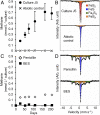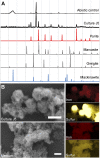Pyrite formation from FeS and H2S is mediated through microbial redox activity
- PMID: 30886102
- PMCID: PMC6452648
- DOI: 10.1073/pnas.1814412116
Pyrite formation from FeS and H2S is mediated through microbial redox activity
Abstract
The exergonic reaction of FeS with H2S to form FeS2 (pyrite) and H2 was postulated to have operated as an early form of energy metabolism on primordial Earth. Since the Archean, sedimentary pyrite formation has played a major role in the global iron and sulfur cycles, with direct impact on the redox chemistry of the atmosphere. However, the mechanism of sedimentary pyrite formation is still being debated. We present microbial enrichment cultures which grew with FeS, H2S, and CO2 as their sole substrates to produce FeS2 and CH4 Cultures grew over periods of 3 to 8 mo to cell densities of up to 2 to 9 × 106 cells per mL-1 Transformation of FeS with H2S to FeS2 was followed by 57Fe Mössbauer spectroscopy and showed a clear biological temperature profile with maximum activity at 28 °C and decreasing activities toward 4 °C and 60 °C. CH4 was formed concomitantly with FeS2 and exhibited the same temperature dependence. Addition of either penicillin or 2-bromoethanesulfonate inhibited both FeS2 and CH4 production, indicating a coupling of overall pyrite formation to methanogenesis. This hypothesis was supported by a 16S rRNA gene-based phylogenetic analysis, which identified at least one archaeal and five bacterial species. The archaeon was closely related to the hydrogenotrophic methanogen Methanospirillum stamsii, while the bacteria were most closely related to sulfate-reducing Deltaproteobacteria, as well as uncultured Firmicutes and Actinobacteria. Our results show that pyrite formation can be mediated at ambient temperature through a microbially catalyzed redox process, which may serve as a model for a postulated primordial iron-sulfur world.
Keywords: biogenic mineral transformation; deep biosphere; origin of life; sulfur cycle; syntrophy.
Copyright © 2019 the Author(s). Published by PNAS.
Conflict of interest statement
The authors declare no conflict of interest.
Figures




Similar articles
-
Microbial acceleration of aerobic pyrite oxidation at circumneutral pH.Geobiology. 2017 Sep;15(5):690-703. doi: 10.1111/gbi.12241. Epub 2017 Apr 27. Geobiology. 2017. PMID: 28452176
-
Examining Pathways of Iron and Sulfur Acquisition, Trafficking, Deployment, and Storage in Mineral-Grown Methanogen Cells.J Bacteriol. 2021 Sep 8;203(19):e0014621. doi: 10.1128/JB.00146-21. Epub 2021 Sep 8. J Bacteriol. 2021. PMID: 34251867 Free PMC article.
-
Organic sulfur compounds resulting from the interaction of iron sulfide, hydrogen sulfide and carbon dioxide in an anaerobic aqueous environment.Orig Life Evol Biosph. 1996 Apr;26(2):131-50. doi: 10.1007/BF01809852. Orig Life Evol Biosph. 1996. PMID: 11536750
-
Reductive biomining of pyrite by methanogens.Trends Microbiol. 2022 Nov;30(11):1072-1083. doi: 10.1016/j.tim.2022.05.005. Epub 2022 May 24. Trends Microbiol. 2022. PMID: 35624031 Review.
-
Energetics and kinetics of the prebiotic synthesis of simple organic acids and amino acids with the FeS-H2S/FeS2 redox couple as reductant.Orig Life Evol Biosph. 1999 Jan;29(1):5-32. doi: 10.1023/a:1006558802113. Orig Life Evol Biosph. 1999. PMID: 10077866 Review.
Cited by
-
Strong local, not global, controls on marine pyrite sulfur isotopes.Sci Adv. 2021 Feb 26;7(9):eabb7403. doi: 10.1126/sciadv.abb7403. Print 2021 Feb. Sci Adv. 2021. PMID: 33637519 Free PMC article.
-
Geochemical Decoupling of Iron and Zinc during Transformation of Zn-Bearing Ferrihydrite in Reducing Sediments.Environ Sci Technol. 2024 Nov 12;58(45):20224-20234. doi: 10.1021/acs.est.4c09261. Epub 2024 Nov 3. Environ Sci Technol. 2024. PMID: 39491537 Free PMC article.
-
Speciation of iron sulfide compounds by means of X-ray Emission Spectroscopy using a compact full-cylinder von Hamos spectrometer.J Anal At Spectrom. 2020;35(11):10.1039/d0ja00244e. doi: 10.1039/d0ja00244e. J Anal At Spectrom. 2020. PMID: 34092880 Free PMC article.
-
Profile of Bacterial Communities in Copper Mine Tailings Revealed through High-Throughput Sequencing.Microorganisms. 2024 Sep 3;12(9):1820. doi: 10.3390/microorganisms12091820. Microorganisms. 2024. PMID: 39338494 Free PMC article.
-
Relative Reactivity and Bioavailability of Mercury Sorbed to or Coprecipitated with Aged Iron Sulfides.Environ Sci Technol. 2019 Jul 2;53(13):7391-7399. doi: 10.1021/acs.est.9b00768. Epub 2019 Jun 18. Environ Sci Technol. 2019. PMID: 31173690 Free PMC article.
References
-
- Rickard D, Luther GW., 3rd Chemistry of iron sulfides. Chem Rev. 2007;107:514–562. - PubMed
-
- Canfield DE, Farquhar J. The global sulfur cycle. In: Knoll H, Canfield DE, Konhauser KO, editors. Fundamentals of Geobiology. John Wiley; Oxford: 2012. pp. 49–64.
-
- Rickard D, Luther GW. Kinetics of pyrite formation by the H2S oxidation of iron(II) monosulfide in aqueous solutions between 25 and 125°C: The mechanism. Geochim Cosmochim Acta. 1997;61:135–147.
-
- Rickard D, Butler IB, Oldroyd A. A novel iron sulphide mineral switch and its implications for Earth and planetary science. Earth Planet Sci Lett. 2001;189:85–91.
-
- Berner RA. Sedimentary pyrite formation. Am J Sci. 1970;268:1–23.
Publication types
MeSH terms
Substances
Associated data
- Actions
- Actions
- Actions
- Actions
LinkOut - more resources
Full Text Sources
Other Literature Sources
Medical
Miscellaneous

